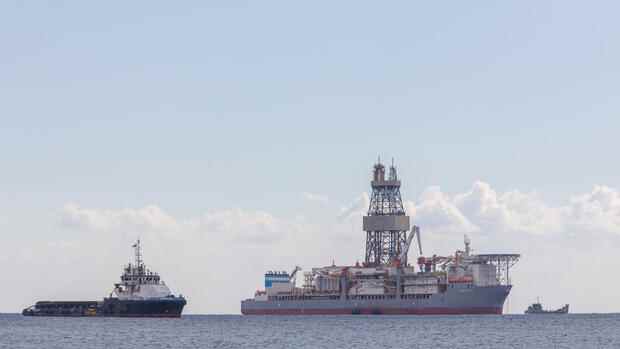Athens Cyprus hopes for Aphrodite. That’s the name of the natural gas field off the south-east coast of the Mediterranean island. It takes its name from the ancient goddess of love who, according to legend, rose out of the surf on a beach in Cyprus. The gas field was discovered back in 2011. “We can start production within three to five years,” said Solon Kassinis, head of the energy department at the Cyprus Ministry of Economy.
By the end of this year, the energy company Chevron, which holds the concession for the Aphrodite field together with Shell plc and the Israeli company New Med, intends to present a concept for developing the deposit. It should also answer the previously unanswered question of how the gas can be exported.
Natasa Pilides, Cyprus’ Minister for Energy, Trade and Industry, is optimistic: in 2027 the island will start exporting natural gas from the Aphrodite field.
Top jobs of the day
Find the best jobs now and
be notified by email.
The minister believes she also has buyers: “Europe is a good potential customer for Cypriot natural gas because the EU has confirmed that gas will remain a bridge fuel until 2049,” Pilides told Bloomberg.
Gas reserves of Cyprus amount to 510 billion cubic meters
Aphrodite’s gas reserves are estimated at 130 billion cubic meters. It’s not the only occurrence. In February 2018, Italy’s Eni and France’s Total discovered the Calypso deposit on their property northwest of Aphrodite. It is estimated to have a volume of 180 billion cubic meters. The following year, Exxon Mobile drilled into the Glaucus gas field a little further south. Around 200 billion cubic meters of natural gas are stored there.
The bottom line is that Cyprus’ proven gas reserves so far amount to 510 billion cubic meters. That is more than five times the consumption in Germany last year. This means that the island republic has the potential to become an important gas supplier for Europe.
But there are political and economic hurdles. The biggest obstacle is the unresolved Cyprus conflict. The island has been divided in two since Turkey occupied the north of the island in the summer of 1974 to prevent feared annexation by Greece. Ankara not only claims parts of the exclusive economic zone (EEZ) that Cyprus is entitled to under the UN Convention on the Law of the Sea. Turkey is also demanding that the Turkish ethnic group in the north of the divided island share in the proceeds from gas production.
>> Also read here: New tensions in the Mediterranean? Turkey sends off drilling ship again
In addition to the political controversies, there are also technical problems. So far, the infrastructure for gas export has been lacking. In January 2020, Greece, Cyprus and Israel signed an agreement in principle to build the East Med pipeline. The 1,900-kilometer pipeline is intended to bring gas from the production areas off Cyprus and Israel via Greece to Italy, where it could be fed into the European grid. However, Turkey has filed an objection to the pipeline because it will pass through a sea area that Ankara claims as its own economic zone.
The profitability of the project, which is estimated at six to seven billion dollars, is also questionable. As a result, the US withdrew its support for the pipeline in January. The project is therefore deemed to have failed.
What remains is the export as liquefied natural gas (LNG). Plans for an LNG terminal near Vassilikos on the south coast of Cyprus were discussed back in the early 2010s, but were not implemented due to doubts about their economic viability. It would be possible to transport the gas from the deposits off Cyprus to the LNG terminal in Idku, Egypt, to liquefy it there and export it in tankers.
Does the EU climate protection schedule make pipeline projects uneconomical?
In mid-June, EU Commission President Ursula von der Leyen signed a declaration of intent with Israel and Egypt. It envisages exports of Israeli gas through the LNG terminal in Egypt. Cyprus could do the same. However, this would require expanding the capacities in Idku and building a pipeline from the production areas off Cyprus to Egypt.
With all decisions for the development of Cypriot deposits and the expansion of an export infrastructure, the question arises for investors as to how long natural gas should be used at all. According to the model calculations of the EU Commission, in 2030 a maximum of 22 percent of gross domestic energy consumption may be accounted for by natural gas.
It remains to be seen whether the groups licensed in Cyprus will be willing to invest billions in gas production, which cannot begin until 2027 at the earliest, against the background of the EU climate targets.
>> Also read here: Israel is to deliver liquefied gas to Europe via Egypt
The EU’s climate change schedule makes projects like the East Med pipeline, which take five to seven years to build and more than 20 years of operation to pay back, uneconomical, says Charles Ellinas, CEO of Cyprus energy consultancy e-CNHC. The same applies to the development of new gas fields, writes Ellinas. In the case of Cyprus, there are also investment risks due to the political tensions with Turkey.
Moritz Rau, who researches energy issues in the eastern Mediterranean at the Science and Politics Foundation, is also skeptical: Rau writes that the construction of adequate transport infrastructure is too expensive and time-consuming, and the unresolved Cyprus conflict and the dispute over sea borders and economic zones are too explosive in a paper.
Instead of building new pipelines, electricity trading could be intensified, with submarine cables like the planned Euro Asia Interconnector and the Euro Africa Interconnector, which should bring green electricity from Israel and Egypt to Europe, says Rau.
More: Trillions of cubic meters of gas are stored under Germany – but there are high hurdles to fracking

